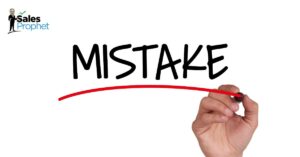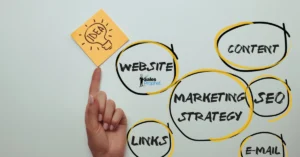In the fast-paced and highly competitive business world, sales performance and efficiency are critical factors determining a company’s success. To stay ahead of the game, businesses must constantly seek innovative ways to enhance their sales strategies and achieve remarkable results. One such strategy that has gained significant attention is sales lead automation.
By leveraging technology and automation tools, businesses can streamline their lead generation and lead nurturing process, resulting in improved sales performance and increased efficiency.
What is Lead Automation?
Lead automation is the process of using data and software to streamline and automate the process salespeople and companies use to generate leads as well as nurture leads who are not sales-ready. It involves using software that stores prospect data and automatically sends cold emails or outbound emails to prospects that match your ideal customer profile (ICP).
Some solutions like Sales Prophet include a customer relationship management (CRM) system to store and track all communications to these prospects. This helps companies identify, engage, and convert prospects into paying customers.
The Importance of Lead Automation for Sales Teams
Lead automation is crucial for sales teams for several reasons:
- Efficiency. With sales lead automation, sales teams can save time hunting for prospects’ contact information and automating repetitive tasks such as sending introductory emails, follow-up emails, and scheduling appointments. This allows them to focus on more critical tasks, such as responding to replies, identifying opportunities, closing deals, and building customer relationships.
- Consistency. Lead automation ensures that all leads are treated consistently, regardless of the size or stage of the sales cycle. This helps maintain a professional image and ensures no lead is left behind.
- Scalability. As your business grows, so does your customer base. Lead automation allows you to handle a larger volume of leads without sacrificing quality or efficiency.
- Data-Driven Decision Making. With lead automation, you have access to valuable data and insights that can help you make informed decisions about your sales strategy. This data can include lead engagement rates, conversion rates, and customer behavior.
How Can Lead Automation Improve Your Sales Performance?
Sales lead automation can have a significant impact on your sales performance in several ways:
Improved Lead Nurturing
Lead nurturing is the process of building relationships with potential customers and guiding them through the sales funnel. With lead automation, you can create personalized and targeted email campaigns that are triggered based on a lead’s behavior or stage in the sales cycle. This allows you to provide relevant and timely information to leads, increasing the chances of conversion. This is important because teh majority of the lead you generate today will not convert for some time, often years later.
Better Lead Qualification
Not all leads are created equal. Some leads may be more likely to convert than others, and it’s essential to prioritize your sales efforts accordingly. Lead automation can help you qualify leads based on specific criteria, such as demographics, behavior, and engagement. This allows you to focus your efforts on leads that are most likely to convert, improving your sales efficiency.
Increased Sales Efficiency
Sales lead automation can help streamline your sales process, making it more efficient and effective. By sending a consistent flow of emails to ideal prospects automatically, the salesperson only needs to monitor their inbox, identify opportunities, book meetings, and close sales. These automation systems are easy to implement and are non-disruptive to a salesperson’s typical workflow. This can lead to increased sales performance and revenue.
Enhanced Customer Experience
Integrating your sales lead automation solution with your CRM or Marketing Automation Platform (MAP) improves your ability to provide a positive customer experience, which is crucial for sales success. Lead automation can help you deliver potential customers a personalized and seamless experience. By using data and insights to tailor your communication and interactions with leads, you can build trust and credibility, making it more likely for them to choose your product or service.
How to Implement Lead Automation in Your Sales Strategy
Now that you understand the benefits of lead automation, let’s explore how to implement it in your sales strategy.
Identify Your Target Audience
The first step in implementing lead automation is to identify your target audience. Who are your ideal customers? What are their pain points, needs, and preferences? By understanding your target audience, you can create targeted and personalized campaigns that resonate with them. For more information on how to create an ideal customer profile go here.
Choose the Sales Automation Platform (SAP)
Many sales lead automation tools are available in the market, and choosing the right ones for your business is essential. Some popular options include Apollo, Reply, and, of course, Sales Prophet. Things to consider include:
- Does the platform include data? Prospect/Contact data can be very expensive. For example, ZoomInfo, one of the largest B2B Data providers, starts at 20k a year for very few contact records (20k) compared to Apollo or Sales Prophet.
- Does the platform offer email verification? Most sales automation platforms dont offer email verification. You must use a third-party email verification service like EmailOversight, Zerobounce or Unbounce to verify your data or risk getting blacklisted because the data is incorrect or, worse, a spam trap.
So, on top of purchasing another service, you will also have to upload your data files, verify the records, download the verified records, and import the final verified contact list into your sales automation platform. This process takes time, driving up your costs. - Does the platform charge for adding additional users? Most sales and marketing automation platforms charge you for each user you want to add. Platforms like Sales Prophet offer unlimited users.
- Does the platform give you both HTML and Text-based email capabilities? Most sales automation platforms, like Apollo, Reply, LemList, etc, dont give you the ability to create branded HTML emails. Having this ability gives you the ability not only to generate leads but also to grow your company brand. Tools like Sales Prohet provides a drag-and-drop email editor for building these emails. Like marketing automation platforms like Marketo or Eloqua work, these branded emails can be used for content syndication and lead nurturing.
- Does the platform give you an unlimited number of email accounts? Most sales and marketing automation platforms charge for the number of email accounts you connect to their platform, similar to how they charge for additional users. With changes in how many emails you can send via Microsoft 365 or Google’s workspace accounts its imperative to pick a sales automation platform that doesn’t charge you by the number of inboxes you have to connect.
The best strategy to improve your email deliverability is to connect multiple email accounts and limit the number of emails sent from each mailbox. This can be very costly if you pick a sales automation solution that charges you by the user or inbox. - Does the platform allow you to turn open and click tracking on or off? The most crucial aspect of any sales automation platform is how much control it gives you over how your emails are sent. Your sales automation platform isn’t going to help you generate leads if you can’t get your emails into the inbox. One way to improve deliverability is to start your sequence with email open tracking and click tracking turned on.
This helps you determine which subject lines and body copy works best when emailing your target audience. Once you have decided which messages work best, turn open and click tracking off to improve deliverability and focus on the number of email replies to receive. - Does the platform connect to your salespeople’s email accounts, and have they gone through the security audit with Google, Office365? Connecting your email accounts should be easy and secure. Otherwise, you will spend a lot of time linking your email accounts and risk bad actors hacking or spoofing your email accounts. Sales Automation apps like Sales Prophet offer one-click integration with the most common email providers and have gone through a security audit with Microsoft, Google, and PWC.
- Does the platform connect to third-party SMTP providers like Mailgun, Sparkpost or Sendgrid? As mentioned above, a popular strategy is to connect as many email accounts as possible and lower the sending volume to ensure your emails get into the inbox vs. the spam folder. However, in some cases, no matter what you do, you still can’t send enough emails to generate the number of leads you need to grow your business.
That’s why Sales Prophet added the ability to connect to a third-party SMTP provider. We have integrated via an API to Mailgun, Sparrkpost, and Sendgrid, allowing you to simply add the API key from one of these three providers and you now have teh ability to send as many emails as you like. We recommend sending less than 5,000 emails daily per SMTP connection, but you can add three SMTP providers and safely send up to 15,000 emails daily.
Create Engaging Content
Content is a crucial aspect of lead automation. Content is the fuel in any lead generation strategy. Some people call Content King but we believe Distribution is King and Content is Queen. No matter how good the content is, no one will see it if you don’t have a way to distribute your content.
Your content should be informative, relevant, and engaging to capture the attention of potential customers. Consider creating different types of content, such as research studies and guides, and then breaking up that content into videos, blog posts, and infographics to appeal to different audiences. No one minds receiving an unsolicited email as long as it’s helpful and relevant.
Segment Your Lists
The first tactic in any effective lead generation strategy is to break up your prospects by personas. Some studies suggest as many as 16 people are involved in any major purchase decision. We are not telling you to break up your lists into 16 different personas but rather focus on the minimum number of personas.
- Researcher — These people are typically involved in researching solutions to problems.
- Influencers — These people might not use your solution directly but can be impacted by another department’s decision to change solutions.
- End Users — These people will be using your product or service the most and report to the decision-maker.
- Decision Maker — These people make the final decision to purchase your product or service and are influenced by everyone involved in the buying process.
- Financial Authority — These people control the budget.
Each persona has different perspectives and questions, which your content must address to get the sale.
The researcher will want to know how your solution compares to others and whether you work for companies in their industry.
The influencer will want to know how your solution is different from their current solution and how it will impact them personally.
The end user will want to know how your solution differs from what they use or do today. How long will it take to learn the new solution, what kind of support will they get, and why is it better than what they are doing today?
The decision maker will want to know if your solution will make their team more efficient and effective. What are the benefits compared to what they are doing today? Do you work for other companies or competitors in the same industry? What kind of results can they expect?
The financial authority will want to know why the company wants to make a change. What are the terms and conditions? What is the escalation policy? What’s the ROI?
As you can see, each persona has unique questions based on their role at the company. Your content must address these questions to be effective with your lead generation efforts.
Buyer Stages
One strategy to ensure you send relevant content to our target audience is creating content for each persona typically involved in the purchase decision at each stage of the buyer’s journey.
We have simplified the buyer journey into these stages
Learn – I think I/we have a problem
Solve – How do I solve this problem
Compare – Are we solving the problem correctly
Purchase – Help me make a purchase decision and why do I pick this company vs. another
Loyalty – Show me you appreciate me as a customer
Create Your Email Campaigns & Sequences & Templates
Email marketing is a powerful tool for lead automation if you take the time to answer each persona’s questions at each stage of the buyer journey above. Think of it as a giant FAQ exercise.
Start creating email introductions for each persona and ask questions you know they are most likely concerned with. Then create email templates and follow-up emails that answer all the questions you have identified for each persona. Think of yourself as a helpful thought leader and you will automatically drive leads for your business.
Monitor and Analyze Your Results
As with any sales strategy, it’s crucial to monitor and analyze your results to make improvements and adjustments. Use the data and insights provided by your lead automation tool to track your progress and make data-driven decisions.
Subject lines – get emails opened.
Body copy – generates responses.
Offers – Lazy offers are no offers at all. Offers must be compelling.
Find the winning combination of subject lines, body copy, and offers, shut off the email open and click tracking, and focus on the number of replies you receive.
Real-World Examples of Lead Automation Success
Many companies have seen significant improvements in their sales performance after implementing lead automation. Here are two real-world examples:
northAmerican Van Lines
northAmerican Van Lines rolled out a commercial division focused on helping mid to large-sized companies with their employee relations and mobility efforts. Since this was a new initiative and and they only had one salesperson in charge of the program, they needed a non-disruptive way to generate leads for this salesperson automatically.
By implementing Sales Prophet’s sales and marketing automation platform, they were able to send mass emails with their latest research to their target audience, generating demand for their new service while also sending automated sales emails to introduce their salesperson.
They have generated millions of dollars in new revenue and thousands of new subscribers to their newsletter featuring their research studies and helpful guides.
Cablevey
Cabelevey develops material handling solutions for companies in the food production industry, i.e., coffee, cereals, pet foods, etc.
They implemented a data-first approach to their lead generation program. They purchase Industrial Info who had data of companies around the world that were either building new food production facilities or expanding existing facilities. Then they implemented Sales Prophet and an account-based lead generation program introducing their salespeople to everyone involved in the buying decision of material handling systems.
This included the plant managers, engineers, and architectural design firms. They copied key stakeholders in the same email which increased response rates by 400% and generated millions of dollars in new opportunities. Not only with new customers but also existing customers.
Who is Responsible for Lead Automation?
Lead automation is a collaborative effort between sales and marketing. Sales teams are responsible for identifying and qualifying leads, while marketing teams create engaging content and manage email campaigns.
Conclusion
In conclusion, lead automation has emerged as a game-changing strategy for businesses looking to boost their sales performance and achieve remarkable results. By harnessing the power of technology and automation tools, companies can streamline their lead generation and nurturing processes, saving time and effort while improving efficiency. From automated email campaigns to personalized lead nurturing, lead automation offers a range of benefits, including increased productivity, consistency, scalability, and data-driven decision making.




